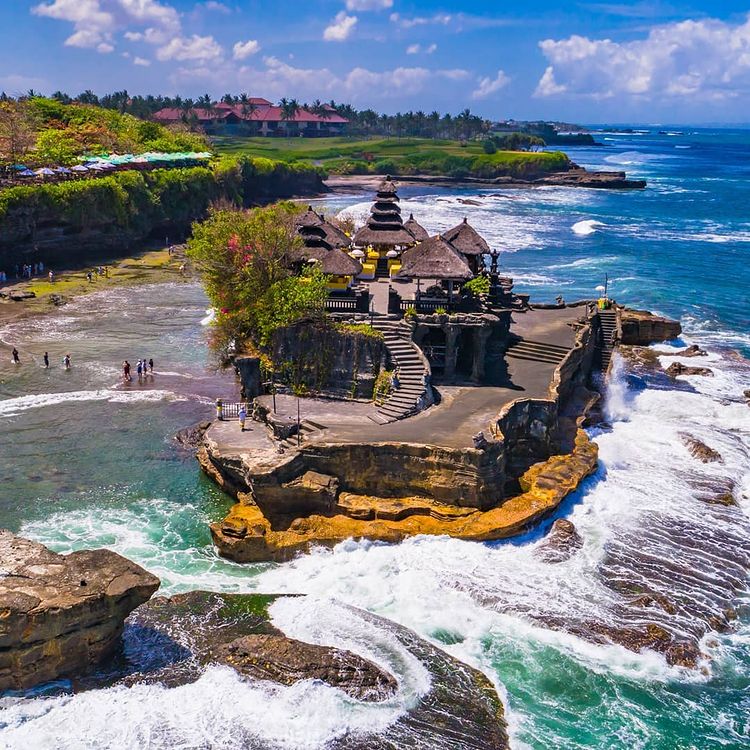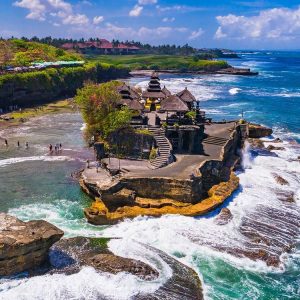
History and Myths of Tanah Lot Temple
Table of Contents

Visa Bali Info – Tanah Lot Temple is a place of worship for Balinese Hindus. Tanah Lot is an exotic tourist spot with views of the sea and the beauty of the sunset.
Tanah Lot Temple is a sacred place, a place of worship for the gods of the sea guard by Hindus.
Tanah Lot Temple is one of the popular tourist attractions from Bali which is unique with the existence of two temples on a large rock.
If from the origin of the word, Tanah Lot itself comes from the word land and “lot” which means sea. In this way Tanah Lot means a small island that floats in the sea.
Tanah Lot is located in Beraban, Kediri, which is about 13 kilometers south of Tabanan City and 30 km west of Denpasar City.
History of Tanah Lot Temple
In the 15th century, Bhagawan Dang Hyang Nirartha or known as Dang Hyang Dwijendra carried out a mission to spread Hinduism from Java to Bali.
It is said that Dang Hyang Nirartha saw a holy light from the southern sea of Bali. So Dang Hyang Nirartha looked for the location of the light. He arrived at a beach in the village of Beraban Tabanan.
At that time, Beraban Village was led by the Bendesa Beraban Sakti, who strongly opposed the teachings of Dang Hyang Nirartha in spreading Hinduism because the Bendesa Beraban Sakti adhered to monotheism.
After meditating on a rock that resembled a parrot and in every way wanted to be expelled by the local authorities, Dang Hyang Nirartha moved the rock (where he meditated) to the middle of the beach with spiritual power. The rock is named Tanah Lot which means rock in the middle of the ocean.
After the incident, the Bendesa Beraban Sakti acknowledged the supernatural power of Dang Hyang Nirartha. He also became his followers to embrace Hinduism along with the entire local population.
There are 7 temples around Tanah Lot Temple

- Penataran Temple
Located north of Tanah Lot Temple, Penataran Temple is a place to pray to the Gods and their manifestations in Tanah Lot Temple for health and happiness.
In this temple there are two days of ceremonies, the first day is the same as Tanah Lot Temple which is held every 210 days on Rebo (Wednesday) Wage, Wara Langkir, and the second day is Rebo (Wednesday) Wage, Wara Merakih, according to the Balinese Calendar.
2. Pengawang Temple
Pengawang Temple is located on the west side of Penataran Temple. This temple was built to pray to God and his manifestations that exist and have power in Tanah Lot Temple as the god of the ocean.
If the tide is high, Hindus cannot pray to Tanah Lot Temple, but they can pray at Pengawang Temple.
3. Pakendungan Temple
Pakendungan Temple is located on the west side of Tanah Lot, only 300 meters from Tanah Lot Temple. Built in the year Caka 1330 to be precise in 1408. This Pakendungan Temple is an integral part of Tanah Lot Temple and is part of the history of Tanah Lot.
4. Njung Galuh Temple
This temple was built to pray to the Goddess of prosperity, namely Dewi Sri, as a power, called Shakti, of Lord Vishnu, the Manifestation of the Protector God.
Hindus pray for fertility of plants including rice plants to achieve prosperity in their lives.
The Enjung Galuh Temple ceremony is held every Umanis Wednesday (Wednesday), Wara Medangsia according to the Balinese calendar.
5. Batu Bolong Temple
Batu Bolong Temple was built to pray to God for holiness or holiness.
The area of Enjung Batu Bolong is a place that is always used to hold Melasti Ceremonies and Pakelem Ceremonies, where the meaning of both Ceremonies is to purify the world.
The Batu Bolong Temple ceremony in the history of Tanah Lot is held every Wednesday (Wednesday) Wage, Wara Langkir according to the Balinese calendar.
6. Batu Mejan Temple
Batu Mejan Temple is located 100 meters on the west side of Batu Bolong Temple. Batu Mejan Temple is also known as Beji Temple, “Beji” means a holy place to get holy water for Hindu ceremonies.
Batu Mejan Temple was built for the villagers as a place to ask God for mercy through holy water. The Batu Mejan Temple ceremony is held every Kliwon Saturday, Wara Kuningan according to the Balinese calendar.
7. Jero Kandang Temple
Jero Kandang Temple is a place to pray to God with his manifestation as the God of all animals and plants and also a place to pray to Dewi Sri as a manifestation of God as the Goddess of prosperity.
The Jero Kandang Temple ceremony is held every Saturday (Saturday) Kliwon, Wara Uye or Tumpek Kandang according to the Balinese calendar.
Myth of Tanah Lot Temple
According to the myth, when Danghyang Nirartha released his supernatural powers, a large stone could move, which was the place of his meditation.
When the stones moved, a temple was built which was guarded by special guards. This guard is also not arbitrary, but was created from Danghyang Nirartha’s shawl and turned into (what is known to the layman as) a “black-and-white snake”.
The snake in a cave is then believed to be able to protect the Hindu community from evil and damage.
So when a disaster occurs this snake will issue a certain sign as a warning. These snakes are found in a cave not far from Tanah Lot, in this cave there are snakes that are believed to be the guardians of the temple in Tanah Lot.
There is Holy Water around Tanah Lot Cave
Well, the specialty of Tanah Lot this time is that not far from the sacred snake cave there is also a holy water cave that has a flow that comes from the middle of the sea. Uniquely, the water that flows in this holy water cave tastes fresh water even though this water comes from the middle of the sea on the island of Bali. In addition, it is also a myth that this holy water can keep us young.
The water source in this sacred cave is sacred, and is used for religious ceremonies for Balinese Hindus.
That’s the history and myth of Tanah Lot Temple that we can share with you. Hopefully you can enjoy Tanah Lot when you are on vacation in Bali, guys..
Bali Visa Agency : www.visa4Bali.com – Experienced specialists managing the entire application process from start to finish.





